Preparation, Properties, and Applications of 2D Janus Transition Metal Dichalcogenides
Abstract
1. Introduction
2. Synthesis of 2D JTMDs
2.1. Chemical Vapor Deposition (CVD)
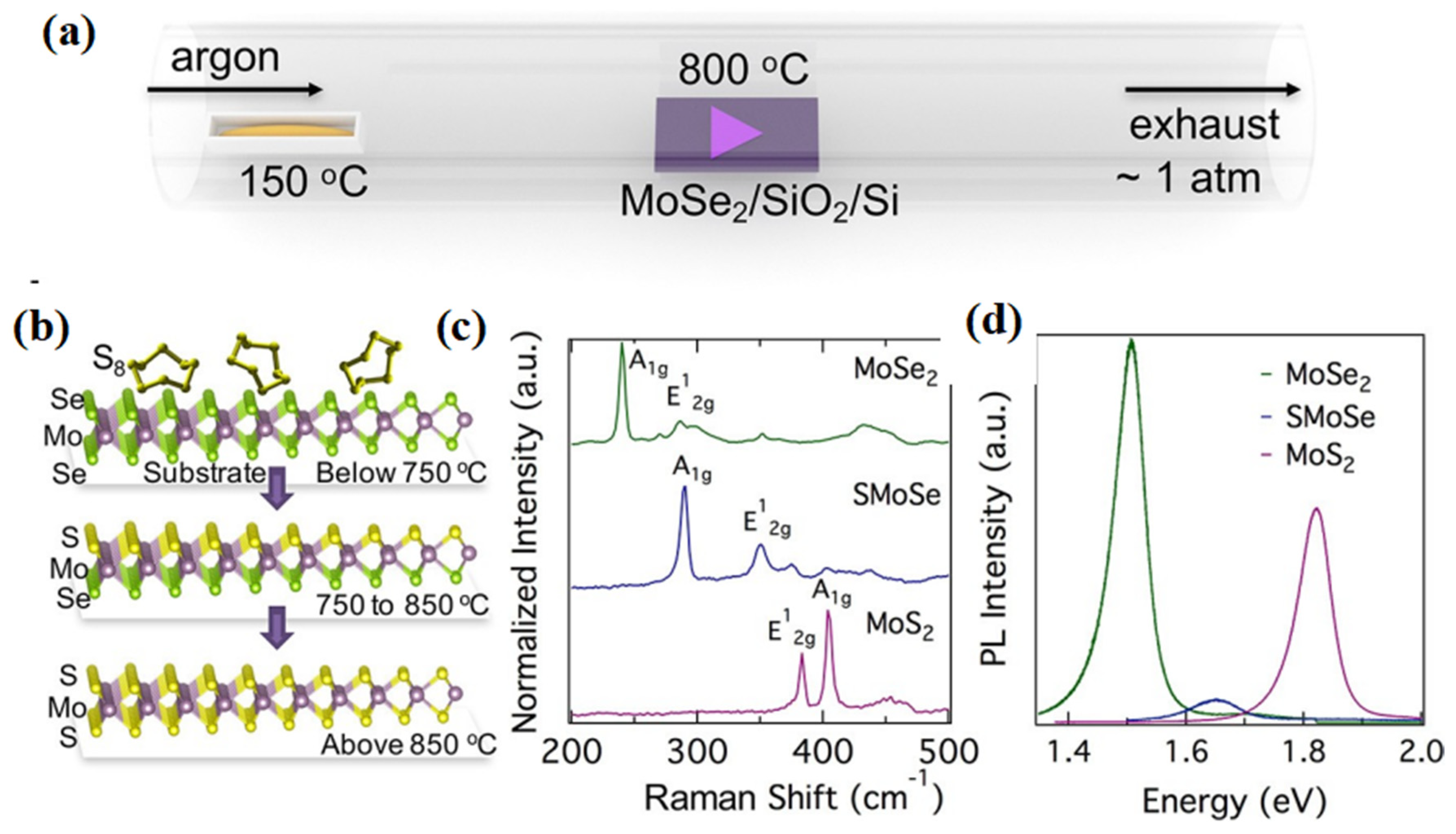
2.2. Pulsed Laser Deposition (PLD)

2.3. Selective Epitaxial Atomic Replacement (SEAR)
2.4. Room Temperature Atomic Layer Substitution (RT-ALS)
2.5. Construction Methods of Heterojunction Structures
3. Atomic Structures of 2D JTMDs
3.1. Asymmetric Structure
3.2. Atomic Structure of JTMDS
4. Properties of 2D JTMDs
4.1. Interlayer Dipole Moment
4.2. Rashba Effect
4.3. Vertical Piezoelectricity
4.4. Two-Dimensional JTMDs Van Der Waals (vdW) Heterojunction Structure
4.5. Thermoelectric Performance
4.6. Nonlinear Optical and Second Harmonic Generation Responses
4.7. Charge Density Wave (CDW) Behavior
4.8. Superconductivity
5. Applications of 2D JTMDs
5.1. Sensors
5.2. Electronic Devices
5.3. Spintronics and Valley Electronics
5.4. Catalysts
5.5. Biomedical Science
6. Summary
7. Outlook
7.1. Improvements in Synthesis
7.2. Exploration of Controllability and Stability
7.3. Janus TMDs and Advanced Electronic Devices
Author Contributions
Funding
Acknowledgments
Conflicts of Interest
References
- Lau, C.S.; Das, S.; Verzhbitskiy, I.; Huang, D.; Zhang, Y.; Talha-Dean, T.; Fu, W.; Venkatakrishnarao, D.; Goh, K.E. Dielectrics for Two-Dimensional Transition-Metal Dichalcogenide Applications. ACS Nano 2023, 17, 9870–9905. [Google Scholar] [CrossRef] [PubMed]
- Chaurasiya, R.; Tyagi, S.; Kale, A.J.; Gupta, G.K.; Kumar, R.; Dixit, A. Advances in Physics and Chemistry of Transition Metal Dichalcogenide Janus Monolayers: Properties, Applications, and Future Prospects. Adv. Theory Simul. 2025, 8, 2400854. [Google Scholar] [CrossRef]
- Liu, Z.; Tee, S.Y.; Guan, G.; Han, M.-Y. Atomically Substitutional Engineering of Transition Metal Dichalcogenide Layers for Enhancing Tailored Properties and Superior Applications. Nano-Micro Lett. 2024, 16, 95. [Google Scholar] [CrossRef]
- Xu, W.; Li, S.; Zhou, S.; Lee, J.K.; Wang, S.; Sarwat, S.G.; Wang, X.; Bhaskaran, H.; Pasta, M.; Warner, J.H. Large Dendritic Monolayer MoS2 Grown by Atmospheric Pressure Chemical Vapor Deposition for Electrocatalysis. ACS Appl. Mater. Interfaces 2018, 10, 4630–4639. [Google Scholar] [CrossRef] [PubMed]
- Xu, W.; Li, S.; Ryu, G.H.; Tang, P.; Pasta, M.; Warner, J.H. Single-Step Chemical Vapor Deposition Growth of Platinum Nanocrystal: Monolayer MoS2 Dendrite Hybrid Materials for Efficient Electrocatalysis. Chem. Mater. 2020, 32, 8243–8256. [Google Scholar] [CrossRef]
- Picker, J.; Ghorbani-Asl, M.; Schaal, M.; Kretschmer, S.; Otto, F.; Gruenewald, M.; Neumann, C.; Fritz, T.; Krasheninnikov, A.V.; Turchanin, A. Atomic Structure and Electronic Properties of Janus SeMoS Monolayers on Au(111). Nano Lett. 2025, 25, 3330–3336. [Google Scholar] [CrossRef]
- Gan, Z.; Paradisanos, I.; Estrada-Real, A.; Picker, J.; Najafidehaghani, E.; Davies, F.; Neumann, C.; Robert, C.; Wiecha, P.; Watanabe, K.; et al. Chemical Vapor Deposition of High-Optical-Quality Large-Area Monolayer Janus Transition Metal Dichalcogenides. Adv. Mater. 2022, 34, 2205226. [Google Scholar] [CrossRef]
- Zhang, L.; Xia, Y.; Li, X.; Li, L.; Fu, X.; Cheng, J.; Pan, R. Janus Two-Dimensional Transition Metal Dichalcogenides. J. Appl. Phys. 2022, 131, 230902. [Google Scholar] [CrossRef]
- Lu, A.-Y.; Zhu, H.; Xiao, J.; Chuu, C.-P.; Han, Y.; Chiu, M.-H.; Cheng, C.-C.; Yang, C.-W.; Wei, K.-H.; Yang, Y.; et al. Janus Monolayers of Transition Metal Dichalcogenides. Nat. Nanotechnol. 2017, 12, 744–749. [Google Scholar] [CrossRef]
- Jang, C.W.; Lee, W.J.; Kim, J.K.; Park, S.M.; Kim, S.; Choi, S.-H. Growth of Two-Dimensional Janus MoSSe by a Single in Situ Process without Initial or Follow-up Treatments. NPG Asia Mater. 2022, 14, 15. [Google Scholar] [CrossRef]
- Zhang, J.; Jia, S.; Kholmanov, I.; Dong, L.; Er, D.; Chen, W.; Guo, H.; Jin, Z.; Shenoy, V.B.; Shi, L.; et al. Janus Monolayer Transition-Metal Dichalcogenides. ACS Nano 2017, 11, 8192–8198. [Google Scholar] [CrossRef] [PubMed]
- Lin, Y.-C.; Liu, C.; Yu, Y.; Zarkadoula, E.; Yoon, M.; Puretzky, A.A.; Liang, L.; Kong, X.; Gu, Y.; Strasser, A.; et al. Low Energy Implantation into Transition-Metal Dichalcogenide Monolayers to Form Janus Structures. ACS Nano 2020, 14, 3896–3906. [Google Scholar] [CrossRef] [PubMed]
- Mahjouri-Samani, M.; Lin, M.-W.; Wang, K.; Lupini, A.R.; Lee, J.; Basile, L.; Boulesbaa, A.; Rouleau, C.M.; Puretzky, A.A.; Ivanov, I.N.; et al. Patterned Arrays of Lateral Heterojunctions within Monolayer Two-Dimensional Semiconductors. Nat. Commun. 2015, 6, 7749. [Google Scholar] [CrossRef]
- Wan, X.; Chen, E.; Yao, J.; Gao, M.; Miao, X.; Wang, S.; Gu, Y.; Xiao, S.; Zhan, R.; Chen, K.; et al. Synthesis and Characterization of Metallic Janus MoSH Monolayer. ACS Nano 2021, 15, 20319–20331. [Google Scholar] [CrossRef] [PubMed]
- Trivedi, D.B.; Turgut, G.; Qin, Y.; Sayyad, M.Y.; Hajra, D.; Howell, M.; Liu, L.; Yang, S.; Patoary, N.H.; Li, H.; et al. Room-Temperature Synthesis of 2D Janus Crystals and Their Heterostructures. Adv. Mater. 2020, 32, 2006320. [Google Scholar] [CrossRef]
- Guo, Y.; Lin, Y.; Xie, K.; Yuan, B.; Zhu, J.; Shen, P.-C.; Lu, A.-Y.; Su, C.; Shi, E.; Zhang, K.; et al. Designing Artificial Two-Dimensional Landscapes via Atomic-Layer Substitution. Proc. Natl. Acad. Sci. USA 2021, 118, e2106124118. [Google Scholar] [CrossRef]
- Deng, Q.; Chen, G.; Duan, Z.; Liu, S.; Zhan, D.; Yan, J.; Jing, P.; Bao, Y.; Xu, J.; Xu, H.; et al. Synthesis of Janus MoSSe on Ti-Au and Its Application for One-Step Lithography Fabrication of Electrochemical Micro-Reactors. Appl. Surf. Sci. 2025, 688, 162356. [Google Scholar] [CrossRef]
- Zuieva, S.; Chen, X. Synthetic Approaches to Molecule-2D Transition Metal Dichalcogenide Heterostructures. Angew. Chem. Int. Ed. 2025, 64, e202424932. [Google Scholar] [CrossRef]
- Zhang, K.; Guo, Y.; Larson, D.T.; Zhu, Z.; Fang, S.; Kaxiras, E.; Kong, J.; Huang, S. Spectroscopic Signatures of Interlayer Coupling in Janus MoSSe/MoS2 Heterostructures. ACS Nano 2021, 15, 14394–14403. [Google Scholar] [CrossRef]
- Castellanos-Gomez, A.; Buscema, M.; Molenaar, R.; Singh, V.; Janssen, L.; van der Zant, H.S.J.; Steele, G.A. Deterministic Transfer of Two-Dimensional Materials by All-Dry Viscoelastic Stamping. 2D Mater. 2014, 1, 011002. [Google Scholar] [CrossRef]
- Oh, Y.; Song, S.; Bae, J. A Review of Bandgap Engineering and Prediction in 2D Material Heterostructures: A DFT Perspective. Int. J. Mol. Sci. 2024, 25, 13104. [Google Scholar] [CrossRef] [PubMed]
- Liu, Y.; Yang, Z.; Jiang, Z.; Qian, Q.; Zhou, S.; Cao, W.; Liu, H.; Qian, K.; Han, L.; Cao, R. Electronic Properties of Janus TMD WSSe/WX2 (X = S, Se) Heterostructure by External Strain: A Hybrid Functional Study. ACS Appl. Energy Mater. 2024, 7, 9986–9995. [Google Scholar] [CrossRef]
- Chen, W.; Hou, X.; Shi, X.; Pan, H. Two-Dimensional Janus Transition Metal Oxides and Chalcogenides: Multifunctional Properties for Photocatalysts, Electronics, and Energy Conversion. ACS Appl. Mater. Interfaces 2018, 10, 35289–35295. [Google Scholar] [CrossRef] [PubMed]
- Wang, J.; Shu, H.; Zhao, T.; Liang, P.; Wang, N.; Cao, D.; Chen, X. Intriguing Electronic and Optical Properties of Two-Dimensional Janus Transition Metal Dichalcogenides. Phys. Chem. Chem. Phys. 2018, 20, 18571–18578. [Google Scholar] [CrossRef]
- Li, R.; Cheng, Y.; Huang, W. Recent Progress of Janus 2D Transition Metal Chalcogenides: From Theory to Experiments. Small 2018, 14, 1802091. [Google Scholar] [CrossRef] [PubMed]
- Petrić, M.M.; Kremser, M.; Barbone, M.; Qin, Y.; Sayyad, Y.; Shen, Y.; Tongay, S.; Finley, J.J.; Botello-Méndez, A.R.; Müller, K. Raman Spectrum of Janus Transition Metal Dichalcogenide Monolayers WSSe and MoSSe. Phys. Rev. B 2021, 103, 035414. [Google Scholar] [CrossRef]
- Guan, Z.; Zheng, Y.-Z.; Tong, W.-Y.; Zhong, N.; Cheng, Y.; Xiang, P.-H.; Huang, R.; Chen, B.-B.; Wei, Z.-M.; Chu, J.; et al. 2D Janus Polarization Functioned by Mechanical Force. Adv. Mater. 2024, 36, 2403929. [Google Scholar] [CrossRef]
- Zhang, K.; Guo, Y.; Ji, Q.; Lu, A.-Y.; Su, C.; Wang, H.; Puretzky, A.A.; Geohegan, D.B.; Qian, X.; Fang, S.; et al. Enhancement of van Der Waals Interlayer Coupling through Polar Janus MoSSe. J. Am. Chem. Soc. 2020, 142, 17499–17507. [Google Scholar] [CrossRef]
- Evarestov, R.A.; Kovalenko, A.V.; Bandura, A.V. First-Principles Study on Stability, Structural and Electronic Properties of Monolayers and Nanotubes Based on Pure Mo(W)S(Se)2 and Mixed (Janus) Mo(W)SSe Dichalcogenides. Phys. E Low-Dimens. Syst. Nanostruct. 2020, 115, 113681. [Google Scholar] [CrossRef]
- Chu, V.-H.; Le, T.-H.; Pham, T.-T.; Nguyen, D.-L. Phonon Transport in Janus Monolayer Siblings: A Comparison of 1T and 2H-ISbTe. RSC Adv. 2023, 13, 4202–4210. [Google Scholar] [CrossRef]
- Querne, M.B.P.; Dias, A.C.; Janotti, A.; Da Silva, J.L.F.; Lima, M.P. Tuning Excitonic Properties of Monochalcogenides via Design of Janus Structures. J. Phys. Chem. C 2024, 128, 12164–12177. [Google Scholar] [CrossRef] [PubMed]
- Oreshonkov, A.S.; Denisenko, Y.G.; Azarapin, N.O.; Voronin, A.S.; Chernodubov, D.A.; Evlashin, S.A.; Volochaev, M.N.; Nemtsev, I.V.; Molokeev, M.S.; Glukhova, P.O.; et al. Synthesis of MoSSe and WSSe via Direct Ampule Method: Exploring Structural and Electronic Properties, Liquid Exfoliation and Electrocatalytic Performance for Hydrogen Production. J. Alloys Compd. 2025, 1028, 180642. [Google Scholar] [CrossRef]
- Bera, A.; Singh, A.; Sorb, Y.A.; Jenjeti, R.N.; Muthu, D.V.S.; Sampath, S.; Narayana, C.; Waghmare, U.V.; Sood, A.K. Chemical Ordering and Pressure-Induced Isostructural and Electronic Transitions in MoSSe Crystal. Phys. Rev. B 2020, 102, 014103. [Google Scholar] [CrossRef]
- Wang, Y.; Ma, X.; Yuan, H.; Li, Z. Ni-Based Janus Pentagonal Monolayers as Promising Water-Splitting Photocatalysts. J. Phys. Chem. C 2022, 126, 20354–20363. [Google Scholar] [CrossRef]
- You, L.; Wang, Y.; Zhou, K. 2D Pentagonal Pd-Based Janus Transition Metal Dichalcogenides for Photocatalytic Water Splitting. Phys. Status Solidi (RRL)—Rapid Res. Lett. 2022, 16, 2100344. [Google Scholar] [CrossRef]
- Hao, J.; Ma, Y.; Jia, B.; Zhang, X.; Zhang, C.; Wu, G.; Chen, W.; Li, Y.; Lu, P. Defect Engineering in Two-Dimensional Janus Pentagonal Noble Metal Sulfide MXY (M=Pd, Pt; X, YS, Se, Te; X≠Y) Materials for Highly Efficient Electrocatalytic Hydrogen Evolution Reaction. Int. J. Hydrogen Energy 2024, 62, 462–472. [Google Scholar] [CrossRef]
- Zheng, T.; Lin, Y.-C.; Yu, Y.; Valencia-Acuna, P.; Puretzky, A.A.; Torsi, R.; Liu, C.; Ivanov, I.N.; Duscher, G.; Geohegan, D.B.; et al. Excitonic Dynamics in Janus MoSSe and WSSe Monolayers. Nano Lett. 2021, 21, 931–937. [Google Scholar] [CrossRef] [PubMed]
- Melitz, W.; Shen, J.; Kummel, A.C.; Lee, S. Kelvin Probe Force Microscopy and Its Application. Surf. Sci. Rep. 2011, 66, 1–27. [Google Scholar] [CrossRef]
- Liu, J.; Shen, T.; Wang, L.; Ren, J.-C.; Liu, W.; Li, S. An Efficient Descriptor for Rapid Determination of Dipole Moments and Band Alignments of 2D Janus Transition-Metal Dichalcogenides. Adv. Funct. Mater. 2024, 34, 2401737. [Google Scholar] [CrossRef]
- Cheng, Y.C.; Zhu, Z.Y.; Tahir, M.; Schwingenschlögl, U. Spin-Orbit–Induced Spin Splittings in Polar Transition Metal Dichalcogenide Monolayers. Europhys. Lett. 2013, 102, 57001. [Google Scholar] [CrossRef]
- Tweedie, M.E.P.; Sheng, Y.; Sarwat, S.G.; Xu, W.; Bhaskaran, H.; Warner, J.H. Inhomogeneous Strain Release during Bending of WS2 on Flexible Substrates. ACS Appl. Mater. Interfaces 2018, 10, 39177–39186. [Google Scholar] [CrossRef] [PubMed]
- Alyörük, M.M.; Aierken, Y.; Çakır, D.; Peeters, F.M.; Sevik, C. Promising Piezoelectric Performance of Single Layer Transition-Metal Dichalcogenides and Dioxides. J. Phys. Chem. C 2015, 119, 23231–23237. [Google Scholar] [CrossRef]
- Lee, J.-H.; Park, J.Y.; Cho, E.B.; Kim, T.Y.; Han, S.A.; Kim, T.-H.; Liu, Y.; Kim, S.K.; Roh, C.J.; Yoon, H.-J.; et al. Reliable Piezoelectricity in Bilayer WSe2 for Piezoelectric Nanogenerators. Adv. Mater. 2017, 29, 1606667. [Google Scholar] [CrossRef]
- Chen, Y.; Tian, Z.; Wang, X.; Ran, N.; Wang, C.; Cui, A.; Lu, H.; Zhang, M.; Xue, Z.; Mei, Y.; et al. 2D Transition Metal Dichalcogenide with Increased Entropy for Piezoelectric Electronics. Adv. Mater. 2022, 34, 2201630. [Google Scholar] [CrossRef]
- Aftab, S.; Hegazy, H.H. Emerging Trends in 2D TMDs Photodetectors and Piezo-Phototronic Devices. Small 2023, 19, 2205778. [Google Scholar] [CrossRef] [PubMed]
- Dong, L.; Lou, J.; Shenoy, V.B. Large In-Plane and Vertical Piezoelectricity in Janus Transition Metal Dichalchogenides. ACS Nano 2017, 11, 8242–8248. [Google Scholar] [CrossRef] [PubMed]
- Duerloo, K.-A.N.; Ong, M.T.; Reed, E.J. Intrinsic Piezoelectricity in Two-Dimensional Materials. J. Phys. Chem. Lett. 2012, 3, 2871–2876. [Google Scholar] [CrossRef]
- Ma, B.; Cui, S.-X.; Zhao, B.; Zhang, G.; Guo, F.; Li, J.; Wang, X.-C. Coexistence of In-Plane and Out-of-Plane Piezoelectricity in Janus WXSiN2 (X = S, Se, Te) Monolayers: Potential Implications for Nanoscale Piezoelectric Devices. ACS Appl. Nano Mater. 2025, 8, 4876–4884. [Google Scholar] [CrossRef]
- Lu, M.; Gao, P.; Su, X.; Liu, P.; Wang, Q. A Boosting Strategy of Photovoltaics by Stacking Monolayer InSe and β-Sb into Heterostructure. Chem. A Eur. J. 2025, 31, e202403637. [Google Scholar] [CrossRef]
- Wang, Q.; Liang, Y.; Yao, H.; Li, J.; Wang, B.; Wang, J. Emerging Negative Differential Resistance Effects and Novel Tunable Electronic Behaviors of the Broken-Gap KAgSe/SiC2 van Der Waals Heterojunction. J. Mater. Chem. C 2020, 8, 8107–8119. [Google Scholar] [CrossRef]
- Xu, H.; Zhu, J.; Zou, G.; Liu, W.; Li, X.; Li, C.; Ryu, G.H.; Xu, W.; Han, X.; Guo, Z.; et al. Spatially Bandgap-Graded MoS2(1−x)Se2x Homojunctions for Self-Powered Visible–Near-Infrared Phototransistors. Nano-Micro Lett. 2020, 12, 26. [Google Scholar] [CrossRef] [PubMed]
- Ai, R.; Cui, X.; Li, Y.; Zhuo, X. Local Strain Engineering of Two-Dimensional Transition Metal Dichalcogenides Towards Quantum Emitters. Nano-Micro Lett. 2025, 17, 104. [Google Scholar] [CrossRef] [PubMed]
- Kaur, S.P.; Dhilip Kumar, T.J. Tuning Structure, Electronic, and Catalytic Properties of Non-Metal Atom Doped Janus Transition Metal Dichalcogenides for Hydrogen Evolution. Appl. Surf. Sci. 2021, 552, 149146. [Google Scholar] [CrossRef]
- Wang, C.; Chen, Y.-X.; Gao, G.; Xu, K.; Shao, H. Theoretical Investigations of Janus WSeTe Monolayer and Related van Der Waals Heterostructures with Promising Thermoelectric Performance. Appl. Surf. Sci. 2022, 593, 153402. [Google Scholar] [CrossRef]
- Wang, Y.; Liu, H.; Ji, H.; Bo, Y.; Zhang, Y.; Yang, X.; Shen, Y. Tunable Optoelectronic Properties of Janus WSeTe/g-GaN van Der Waals Heterostructures by Strain Engineering. Mater. Today Commun. 2025, 44, 111889. [Google Scholar] [CrossRef]
- Tan, H.; Xu, W.; Sheng, Y.; Lau, C.S.; Fan, Y.; Chen, Q.; Tweedie, M.; Wang, X.; Zhou, Y.; Warner, J.H. Lateral Graphene-Contacted Vertically Stacked WS2/MoS2 Hybrid Photodetectors with Large Gain. Adv. Mater. 2017, 29, 1702917. [Google Scholar] [CrossRef]
- Xu, W.; Kozawa, D.; Liu, Y.; Sheng, Y.; Wei, K.; Koman, V.B.; Wang, S.; Wang, X.; Jiang, T.; Strano, M.S.; et al. Determining the Optimized Interlayer Separation Distance in Vertical Stacked 2D WS2:hBN:MoS2 Heterostructures for Exciton Energy Transfer. Small 2018, 14, 1703727. [Google Scholar] [CrossRef]
- Xu, W.; Kozawa, D.; Zhou, Y.; Wang, Y.; Sheng, Y.; Jiang, T.; Strano, M.S.; Warner, J.H. Controlling Photoluminescence Enhancement and Energy Transfer in WS2:hBN:WS2 Vertical Stacks by Precise Interlayer Distances. Small 2020, 16, 1905985. [Google Scholar] [CrossRef]
- Kopaczek, J.; Sayyad, M.Y.; Sailus, R.; Wu, C.-L.; Moosavy, S.T.R.; Ruddick, H.; Kudrawiec, R.; Tongay, S.A. Promoting Interlayer Exciton in Janus/Transition Metal Dichalcogenide Heterostructures by Annealing. ACS Appl. Electron. Mater. 2025, 7, 997–1003. [Google Scholar] [CrossRef]
- Liu, Q.H.; Shi, H.L.; Han, Q.Z.; Yang, J.; Zhao, Y.H.; Gong, L.J.; Yang, H.; Cheng, R.S.; Jiang, Z.T. Influence of Janus Structure on the Thermoelectric Performance of the α-Se Monolayer. J. Appl. Phys. 2024, 136, 205704. [Google Scholar] [CrossRef]
- Han, D.; Qin, H.; Tu, H.; Chen, Y.; Sun, H.; Xue, Y.; Zeng, X. Comparative Analysis of Phonon Thermal Transport Properties in 2D Janus TMDC Monolayers: Insights from First-Principles Calculations. J. Electron. Mater. 2025, 54, 2180–2191. [Google Scholar] [CrossRef]
- Xia, Q.; Liu, Y.; Gao, G. Enhanced Thermoelectric Performance and Reversed Anisotropy in the Janus Penta-PdSeTe Monolayer via Biaxial Strain. J. Mater. Chem. C 2025, 13, 5689–5699. [Google Scholar] [CrossRef]
- Sgouros, A.P.; Michos, F.I.; Sigalas, M.M.; Kalosakas, G. Thermal Relaxation in Janus Transition Metal Dichalcogenide Bilayers. Materials 2024, 17, 4200. [Google Scholar] [CrossRef]
- Miao, T.; Xiang, M.; Chen, D.; An, M.; Ma, W. Thermal Transport Characteristics of Two-Dimensional t-PdTe2 and Its Janus Structures. Int. J. Heat Mass Transf. 2022, 183, 122099. [Google Scholar] [CrossRef]
- Orenstein, J.; Moore, J.E.; Morimoto, T.; Torchinsky, D.H.; Harter, J.W.; Hsieh, D. Topology and Symmetry of Quantum Materials via Nonlinear Optical Responses. Annu. Rev. Condens. Matter Phys. 2021, 12, 247–272. [Google Scholar] [CrossRef]
- Shi, J.; Xu, H.; Heide, C.; HuangFu, C.; Xia, C.; de Quesada, F.; Shen, H.; Zhang, T.; Yu, L.; Johnson, A.; et al. Giant Room-Temperature Nonlinearities in a Monolayer Janus Topological Semiconductor. Nat. Commun. 2023, 14, 4953. [Google Scholar] [CrossRef]
- Li, S.-Q.; He, C.; Liu, H.; Zhao, L.; Xu, X.; Chen, M.; Wang, L.; Zhao, J.; Gao, J. Dramatically Enhanced Second Harmonic Generation in Janus Group-III Chalcogenide Monolayers. Adv. Opt. Mater. 2022, 10, 2200076. [Google Scholar] [CrossRef]
- Wilson, J.A.; Di Salvo, F.J.; Mahajan, S. Charge-Density Waves and Superlattices in the Metallic Layered Transition Metal Dichalcogenides. Adv. Phys. 2001, 50, 1171–1248. [Google Scholar] [CrossRef]
- Sui, C.-H.; Qiao, S.-X.; Ding, H.; Jiang, K.-Y.; Shang, S.-Y.; Lu, H.-Y. Two-Dimensional Janus MoSeH with Tunable Charge Density Wave, Superconductivity and Topological Properties. Mater. Today Phys. 2025, 53, 101698. [Google Scholar] [CrossRef]
- Xie, H.; Huang, Z.; Zhao, Y.; Huang, H.; Li, G.; Gu, Z.; Zeng, S. Strong Electron–Phonon Coupling and Multigap Superconductivity in 2H/1T Janus MoSLi Monolayer. J. Chem. Phys. 2024, 160, 234707. [Google Scholar] [CrossRef]
- Qiao, S.-X.; Jiang, K.-Y.; Sui, C.-H.; Xiao, P.-C.; Jiao, N.; Lu, H.-Y.; Zhang, P. Prediction of Charge Density Wave, Superconductivity and Topology Properties in Two-Dimensional Janus 2H/1T-WXH (X = S, Se). Mater. Today Phys. 2024, 46, 101485. [Google Scholar] [CrossRef]
- Kopar, A.S.; Coşkun, A.; Özerbaş, Z.E.; Küçük, B.A.; Turalıoğlu, K.; Çoban, Ö.; Çağlar, M.A.; Ertuğrul, M.; Turgut, G. Recent Studies of Theoretical Gas Sensing Properties of 2D TMDC Janus Materials. Sens. Actuators A Phys. 2025, 383, 116236. [Google Scholar] [CrossRef]
- Jin, C.; Tang, X.; Tan, X.; Smith, S.C.; Dai, Y.; Kou, L. A Janus MoSSe Monolayer: A Superior and Strain-Sensitive Gas Sensing Material. J. Mater. Chem. A 2019, 7, 1099–1106. [Google Scholar] [CrossRef]
- Chaurasiya, R.; Dixit, A. Defect Engineered MoSSe Janus Monolayer as a Promising Two Dimensional Material for NO2 and NO Gas Sensing. Appl. Surf. Sci. 2019, 490, 204–219. [Google Scholar] [CrossRef]
- Fuh, H.-R.; Bau, J.-Y.; Chang, C.-R. Selectivity of Carbon Dioxide and Nitrogen Capture on Monolayer and Bilayer Janus MoSSe: A First Principles Study. J. Mater. Sci. 2025, 60, 3815–3829. [Google Scholar] [CrossRef]
- He, W.; Xu, Y.; Wu, Z.; Hou, Z.; Qin, W.; Liu, X.; Shi, J.; Long, Y. Adsorption of Nitrogen-Containing Toxic Gases on Transition Metal (Pt, Ag, Au)-Modified Janus ZrSSe Monolayers for Sensing Applications: A DFT Study. ACS Appl. Nano Mater. 2025, 8, 3163–3174. [Google Scholar] [CrossRef]
- Jia, S.; Bandyopadhyay, A.; Kumar, H.; Zhang, J.; Wang, W.; Zhai, T.; Shenoy, V.B.; Lou, J. Biomolecular Sensing by Surface-Enhanced Raman Scattering of Monolayer Janus Transition Metal Dichalcogenide. Nanoscale 2020, 12, 10723–10729. [Google Scholar] [CrossRef]
- Yu, C.; Wang, Z. Strain Engineering and Electric Field Tunable Electronic Properties of Janus MoSSe/WX2 (X = S, Se) van Der Waals Heterostructures. Phys. Status Solidi (b) 2019, 256, 1900261. [Google Scholar] [CrossRef]
- Chen, E.; Zhu, Q.; Duan, Y.; Tang, J.; Zhan, R.; Huang, J.; Wan, X.; Chen, K.; Deng, S. Janus Electronic Devices with Ultrathin High-κ Gate Dielectric Directly Integrated on 1T′-MoTe2. ACS Appl. Mater. Interfaces 2024, 16, 68211–68220. [Google Scholar] [CrossRef]
- Kim, S.W.; Choi, S.Y.; Lim, S.H.; Ko, E.B.; Kim, S.; Park, Y.C.; Lee, S.; Kim, H.H. Understanding Solvent-Induced Delamination and Intense Water Adsorption in Janus Transition Metal Dichalcogenides for Enhanced Device Performance. Adv. Funct. Mater. 2024, 34, 2308709. [Google Scholar] [CrossRef]
- Ahmad, W.; Wang, Y.; Kazmi, J.; Younis, U.; Mubarak, N.M.; Aleithan, S.H.; Channa, A.I.; Lei, W.; Wang, Z. Janus 2D Transition Metal Dichalcogenides: Research Progress, Optical Mechanism and Future Prospects for Optoelectronic Devices. Laser Photonics Rev. 2025, 19, 2400341. [Google Scholar] [CrossRef]
- Ke, Y.; Yuan, L.; Xu, W.; Hu, Y.; Hao, Q.; Liu, J.; Zhu, J.; Tu, Y.; Zhang, Q.; Zhang, W. Ultra-Fast Weak Light Detectors Based on van Der Waals Stacked 2D Semiconductor/h-BN Heterostructures. Adv. Opt. Mater. 2025, 13, 2402226. [Google Scholar] [CrossRef]
- Sun, N.; Ye, H.; Quhe, R.; Liu, Y.; Wang, M. Prediction of Photogalvanic Effect Enhancement in Janus Transition Metal Dichalcogenide Monolayers Induced by Spontaneous Curling. Appl. Surf. Sci. 2023, 619, 156730. [Google Scholar] [CrossRef]
- Beshir, B.T.; Obodo, K.O.; Asres, G.A. Janus Transition Metal Dichalcogenides in Combination with MoS2 for High-Efficiency Photovoltaic Applications: A DFT Study. RSC Adv. 2022, 12, 13749–13755. [Google Scholar] [CrossRef]
- Peng, Y.; Li, X.; Tang, X.; Jiao, J.; Zhu, Q.; Cao, J. Prediction of High Carrier Mobility for Novel Janus Mo8S6Se6 Monolayers with Different Phases: First Principles Calculations. J. Mater. Chem. C 2024, 12, 15024–15031. [Google Scholar] [CrossRef]
- Hanan, Z.; Adil, M.; El Hassan, E.H.; Kamal, A.; Abir, B.; Mustapha, E.H.; Hatim, B.; Farid, B.A.; Mohamed, Z. First-Principles Investigations of Structural, Electronic and Optical Properties of Janus GaXY (X/YS, Se, Te)/GeAs van Der Waals Heterostructures for Photovoltaic Applications. Phys. B Condens. Matter 2024, 678, 415728. [Google Scholar] [CrossRef]
- Han, J.; Deng, W.; Hu, F.; Han, S.; Wang, Z.; Fu, Z.; Zhou, H.; Yu, H.; Gou, J.; Wang, J. 2D Materials-Based Photodetectors with Bi-Directional Responses in Enabling Intelligent Optical Sensing. Adv. Funct. Mater. 2025, 2423360. [Google Scholar] [CrossRef]
- Liu, H.; Huang, Z.; Luo, C.; Guo, G.; Peng, X.; Qi, X.; Zhong, J. Spin-Induced Valley Polarization in Heterobilayer Janus Transition-Metal Dichalcogenides. J. Phys. D Appl. Phys. 2023, 56, 325302. [Google Scholar] [CrossRef]
- Hu, T.; Jia, F.; Zhao, G.; Wu, J.; Stroppa, A.; Ren, W. Intrinsic and Anisotropic Rashba Spin Splitting in Janus Transition-Metal Dichalcogenide Monolayers. Phys. Rev. B 2018, 97, 235404. [Google Scholar] [CrossRef]
- Liu, Y.; Wang, S.; Li, F. A New 2D Janus Family with Multiple Properties: Auxetic Behavior, Straintunable Photocatalyst, High Curie Temperature Ferromagnets, and Piezoelectric Quantum Anomalous Hall Insulator. Sci. China Mater. 2024, 67, 1160–1172. [Google Scholar] [CrossRef]
- Vojáček, L.; Medina Dueñas, J.; Li, J.; Ibrahim, F.; Manchon, A.; Roche, S.; Chshiev, M.; García, J.H. Field-Free Spin–Orbit Torque Switching in Janus Chromium Dichalcogenides. Nano Lett. 2024, 24, 11889–11894. [Google Scholar] [CrossRef] [PubMed]
- Wang, Z.; Qureshi, A.H.; Duan, Y.; Liu, Y.; Wang, Y.; Zhu, J.; Lu, J.; Guo, T.; Liu, Y.; Zhang, X. Prediction of Two-Dimensional Janus Transition-Metal Chalcogenides: Robust Ferromagnetic Semiconductor with High Curie Temperature. Molecules 2024, 29, 3915. [Google Scholar] [CrossRef] [PubMed]
- Gebredingle, Y.; Kim, H.; Kim, N. Defect States in Magnetically “Seasoned” WSSe—Adsorption and Doping Effects of Magnetic Transition Metals X = V, Cr, Mn, Fe, Co—A Comprehensive First-Principles Study. Sci. Rep. 2024, 14, 29271. [Google Scholar] [CrossRef] [PubMed]
- Zhao, G.-D.; Fu, W.; Li, Y.; Liu, X.; Jia, F.; Hu, T.; Ren, W. Hidden Valley Polarization, Piezoelectricity, and Dzyaloshinskii–Moriya Interactions of Janus Vanadium Dichalcogenides. ACS Appl. Mater. Interfaces 2024, 16, 1268–1275. [Google Scholar] [CrossRef]
- Yagmurcukardes, M.; Qin, Y.; Ozen, S.; Sayyad, M.; Peeters, F.M.; Tongay, S.; Sahin, H. Quantum Properties and Applications of 2D Janus Crystals and Their Superlattices. Appl. Phys. Rev. 2020, 7, 011311. [Google Scholar] [CrossRef]
- Yang, F.; Record, M.-C.; Boulet, P. Self-Defined Monolayers, Bilayers and Trilayers of Two-Dimensional Janus MoSSe and Ga2SSe van Der Waals Homojunctions as Potential Photocatalysts for Overall Water Splitting. Renew. Energy 2025, 245, 122829. [Google Scholar] [CrossRef]
- Ju, L.; Bie, M.; Tang, X.; Shang, J.; Kou, L. Janus WSSe Monolayer: An Excellent Photocatalyst for Overall Water Splitting. ACS Appl. Mater. Interfaces 2020, 12, 29335–29343. [Google Scholar] [CrossRef]
- Xia, C.; Xiong, W.; Du, J.; Wang, T.; Peng, Y.; Li, J. Universality of Electronic Characteristics and Photocatalyst Applications in the Two-Dimensional Janus Transition Metal Dichalcogenides. Phys. Rev. B 2018, 98, 165424. [Google Scholar] [CrossRef]
- Ma, X.; Wu, X.; Wang, H.; Wang, Y. A Janus MoSSe Monolayer: A Potential Wide Solar-Spectrum Water-Splitting Photocatalyst with a Low Carrier Recombination Rate. J. Mater. Chem. A 2018, 6, 2295–2301. [Google Scholar] [CrossRef]
- Lin, L.; Sherrell, P.; Liu, Y.; Lei, W.; Zhang, S.; Zhang, H.; Wallace, G.G.; Chen, J. Engineered 2D Transition Metal Dichalcogenides—A Vision of Viable Hydrogen Evolution Reaction Catalysis. Adv. Energy Mater. 2020, 10, 1903870. [Google Scholar] [CrossRef]
- Er, D.; Ye, H.; Frey, N.C.; Kumar, H.; Lou, J.; Shenoy, V.B. Prediction of Enhanced Catalytic Activity for Hydrogen Evolution Reaction in Janus Transition Metal Dichalcogenides. Nano Lett. 2018, 18, 3943–3949. [Google Scholar] [CrossRef]
- Xiao, C.; Sa, R.; Ma, Z.; Cui, Z.; Du, W.; Sun, X.; Li, Q.; Deng, H. High-Throughput Screening of Transition Metal Single-Atom Catalyst Anchored on Janus MoSSe Basal Plane for Hydrogen Evolution Reaction. Int. J. Hydrogen Energy 2021, 46, 10337–10345. [Google Scholar] [CrossRef]
- Shi, W.; Li, G.; Wang, Z. Triggering Catalytic Active Sites for Hydrogen Evolution Reaction by Intrinsic Defects in Janus Monolayer MoSSe. J. Phys. Chem. C 2019, 123, 12261–12267. [Google Scholar] [CrossRef]
- Zhao, Y.-M.; Ren, P.; Ma, X.-Y.; Lewis, J.P.; Yan, Q.-B.; Su, G. Effects of Vacancy and Ti Doping in 2D Janus MoSSe on Photocatalysis. J. Phys. Chem. C 2021, 125, 11939–11949. [Google Scholar] [CrossRef]
- Verma, A.; Dutta, A. Chalcogen Vacancy-Enhanced Electrocatalytic Activity of 2D Janus NbSSe Monolayers for Hydrogen Evolution. Int. J. Hydrogen Energy, 2024; in press. [Google Scholar] [CrossRef]
- Chen, T.; Shen, L.; Wang, F.; Jiang, P. Tunable Hydrogen Evolution Reaction Property of Janus SWSe Monolayer Using Defect and Strain Engineering. Molecules 2025, 30, 1588. [Google Scholar] [CrossRef]
- Xu, W.; Wu, Y.; Xi, S.; Wang, Y.; Wang, Y.; Ke, Y.; Ding, L.; Wang, X.; Yang, J.; Zhang, W.; et al. Ultrathin Transition Metal Oxychalcogenide Catalysts for Oxygen Evolution in Acidic Media. Nat. Synth. 2025, 4, 327–335. [Google Scholar] [CrossRef] [PubMed]
- Meng, Y.; Wang, T.-T.; Chen, J.; Cheng, S.-B. Single-Atom W Anchored Janus Transition Metal Dichalcogenides as a Promising Catalyst for the Ammonia Synthesis. Appl. Surf. Sci. 2023, 640, 158470. [Google Scholar] [CrossRef]
- Yang, X.; Lin, L.; Guo, X.; Zhang, S. Design of Multifunctional Electrocatalysts for ORR/OER/HER/HOR: Janus Makes Difference. Small 2024, 20, 2404000. [Google Scholar] [CrossRef]
- Chao, L.; Lin, J.; Hu, Q.; Yan, S.; Mahyoub, S.A.; Wei, Z.; Wu, Y.; Cheng, Z. Reaction Environment Optimization with Janus Electrode in CO2 Electrochemical Reduction to CO. Sep. Purif. Technol. 2025, 362, 131799. [Google Scholar] [CrossRef]
- He, Y.-P.; Wu, S.-Y.; Guo, J.-X.; Guo, T.-H.; Li, X.-Y. A Study on the Single Atom Cu Adsorbed Janus MoSSe Monolayer as the Catalyst for Reduction of CO2 to HCOOH. Mol. Catal. 2023, 549, 113511. [Google Scholar] [CrossRef]
- Zhang, X.; Liu, C.; Lyu, Y.; Xing, N.; Li, J.; Song, K.; Yan, X. NIR-Propelled Janus Nanomotors for Active Photoacoustic Imaging and Synergistic Photothermal/Chemodynamic Therapy. J. Colloid Interface Sci. 2023, 648, 457–472. [Google Scholar] [CrossRef] [PubMed]
- Dar, G.I.; Zubair Iqbal, M.; Wu, A. Multifunctional Biocompatible Janus Nanostructures for Biomedical Applications. Curr. Opin. Biomed. Eng. 2019, 10, 79–88. [Google Scholar] [CrossRef]
- Liang, S.; Deng, X.; Chang, Y.; Sun, C.; Shao, S.; Xie, Z.; Xiao, X.; Ma, P.; Zhang, H.; Cheng, Z.; et al. Intelligent Hollow Pt-CuS Janus Architecture for Synergistic Catalysis-Enhanced Sonodynamic and Photothermal Cancer Therapy. Nano Lett. 2019, 19, 4134–4145. [Google Scholar] [CrossRef]
- Zheng, X.; Zhou, Y.; Guo, Y. Symmetry Manipulation of Two-Dimensional Semiconductors by Janus Structure. Acc. Mater. Res. 2024, 6, 124–128. [Google Scholar] [CrossRef]
- Tang, X.; Kou, L. 2D Janus Transition Metal Dichalcogenides: Properties and Applications. Phys. Status Solidi (b) 2022, 259, 2100562. [Google Scholar] [CrossRef]
- Yang, X.; Wärnå, J.P.A.; Wang, J.; Zhang, P.; Luo, W.; Ahuja, R. Enhanced Overall Water Splitting under Visible Light of MoSSe∣WSSe Heterojunction by Lateral Interfacial Engineering. J. Catal. 2021, 404, 18–31. [Google Scholar] [CrossRef]
- Backman, J.; Lee, Y.; Luisier, M. Electron-Phonon Calculations Using a Wannier-Based Supercell Approach: Applications to the Monolayer MoS2 Mobility. Solid-State Electron. 2022, 198, 108461. [Google Scholar] [CrossRef]
- Zhang, L.; Yang, T.; Sahdan, M.F.; Arramel; Xu, W.; Xing, K.; Feng, Y.P.; Zhang, W.; Wang, Z.; Wee, A.T.S. Precise Layer-Dependent Electronic Structure of MBE-Grown PtSe2. Adv. Electron. Mater. 2021, 7, 2100559. [Google Scholar] [CrossRef]
- Zhu, Q.; Chen, E.; Fan, K.; Tang, J.; Zhan, R.; Wong, K.S.; Chen, Z.; Wan, X.; Chen, K. Robust Plasma-Assisted Growth of 2D Janus Transition Metal Dichalcogenides and Their Enhanced Photoluminescent Properties. Small Methods 2024, 9, 2401310. [Google Scholar] [CrossRef]
- Kong, D.; Li, P.; Cui, S.; Xu, Y.; Wei, H.; Zheng, X.; Peng, M. Exploiting III-Nitride Surface Polarity to Facilitate the Controllable Formation of Janus MoSSe Architectures. Surf. Interfaces 2025, 56, 105670. [Google Scholar] [CrossRef]
- Sayyad, M.; Kopaczek, J.; Gilardoni, C.M.; Chen, W.; Xiong, Y.; Yang, S.; Watanabe, K.; Taniguchi, T.; Kudrawiec, R.; Hautier, G.; et al. The Defects Genome of Janus Transition Metal Dichalcogenides. Adv. Mater. 2024, 36, 2403583. [Google Scholar] [CrossRef] [PubMed]
- Liu, H.; Yang, L.; Zhao, Y.; Sun, S.; Wei, X. Exploring Optoelectronic and Thermal Characteristics of Janus MoSeTe and WSeTe Monolayers under Mechanical Strain. Mater. Today Commun. 2024, 40, 109570. [Google Scholar] [CrossRef]
- Chen, T.; Liu, G.; Dong, X.; Li, H.; Zhou, G. First-Principles Study on the Tunable Electronic and Magnetic Properties of a Janus GaInSeTe Nanosheet via Strain and Defect Engineering. J. Electron. Mater. 2022, 51, 2212–2220. [Google Scholar] [CrossRef]
- Meng, M.; Li, T.; Li, S.; Liu, K. Ferromagnetism Induced by Point Defect in Janus Monolayer MoSSe Regulated by Strain Engineering. J. Phys. D Appl. Phys. 2018, 51, 105004. [Google Scholar] [CrossRef]
- Gao, Y.; Okada, S. Energetics and Electronic Structure of Bilayer Janus WSSe. Appl. Phys. Express 2023, 16, 075004. [Google Scholar] [CrossRef]
- Han, P.; Zhang, J.; Shi, S.; Zhao, Y.; Zhang, Y.; Wang, J. Machine Learning Assisted Screening of Two Dimensional Chalcogenide Ferromagnetic Materials with Dzyaloshinskii Moriya Interaction. npj Comput. Mater. 2024, 10, 232. [Google Scholar] [CrossRef]
- Jiang, Y.; Lei, S.; Jiang, Y.; Wang, M. Highly Stable Two-Dimensional Janus Transition Metal Dichalcogenide-Based van Der Waals Heterostructures for Exceptional Solar Cell Performance. Surf. Interfaces 2024, 52, 104830. [Google Scholar] [CrossRef]
- Bahadursha, N.; Bansal, G.; Tiwari, A.; Bhattacharjee, A.; Kanungo, S. Janus Molybdenum Di-Chalcogenides Based van Der Waals Bilayers for Supercapacitor Electrode Design- Effects of Interlayer Stacking Orientations on Quantum Capacitance. Phys. E Low-Dimens. Syst. Nanostruct. 2024, 159, 115936. [Google Scholar] [CrossRef]
- Zhang, X.; Pan, J.; Hai, W.; Zhang, C.; Wang, X.; Chen, H.; Huang, W.; Li, Z.; Shao, G.; Jiang, J.; et al. Moisture-Wicking Janus-Structure Electronic Knitted Fabric for Multimodal Wearable Mechanical Sensing. Chem. Eng. J. 2024, 498, 155730. [Google Scholar] [CrossRef]
- Li, K.; Yang, H.-C.; Xu, Z.-K. Designing Janus Two-Dimensional Porous Materials for Unidirectional Transport: Principles, Applications, and Challenges. ACS Appl. Polym. Mater. 2024, 6, 14190–14203. [Google Scholar] [CrossRef]
- Chen, J.; Xu, W. 2D-Materials-Based Optoelectronic Synapses for Neuromorphic Applications. eScience 2023, 3, 100178. [Google Scholar] [CrossRef]
- Hui, F.; Zhang, C.; Yu, H.; Han, T.; Weber, J.; Shen, Y.; Xiao, Y.; Li, X.; Zhang, Z.; Liu, P. Self-Assembly of Janus Graphene Oxide via Chemical Breakdown for Scalable High-Performance Memristors. Adv. Funct. Mater. 2024, 34, 2302073. [Google Scholar] [CrossRef]
- Meng, J.; Wang, T.; He, Z.; Li, Q.; Zhu, H.; Ji, L.; Chen, L.; Sun, Q.; Zhang, D.W. A High-Speed 2D Optoelectronic in-Memory Computing Device with 6-Bit Storage and Pattern Recognition Capabilities. Nano Res. 2022, 15, 2472–2478. [Google Scholar] [CrossRef]
- Montes-García, V.; Samorì, P. Janus 2D Materials via Asymmetric Molecular Functionalization. Chem. Sci. 2022, 13, 315–328. [Google Scholar] [CrossRef]
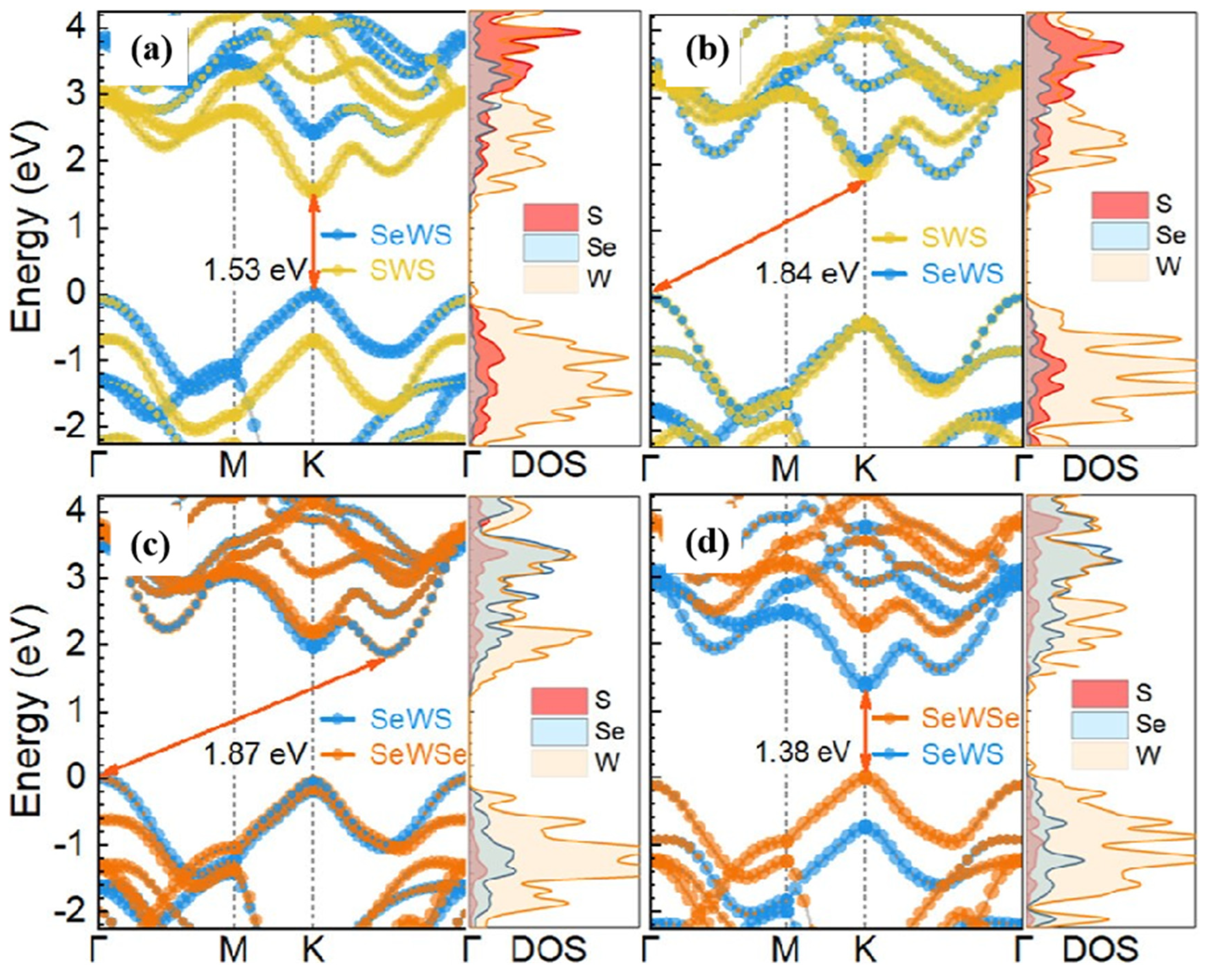
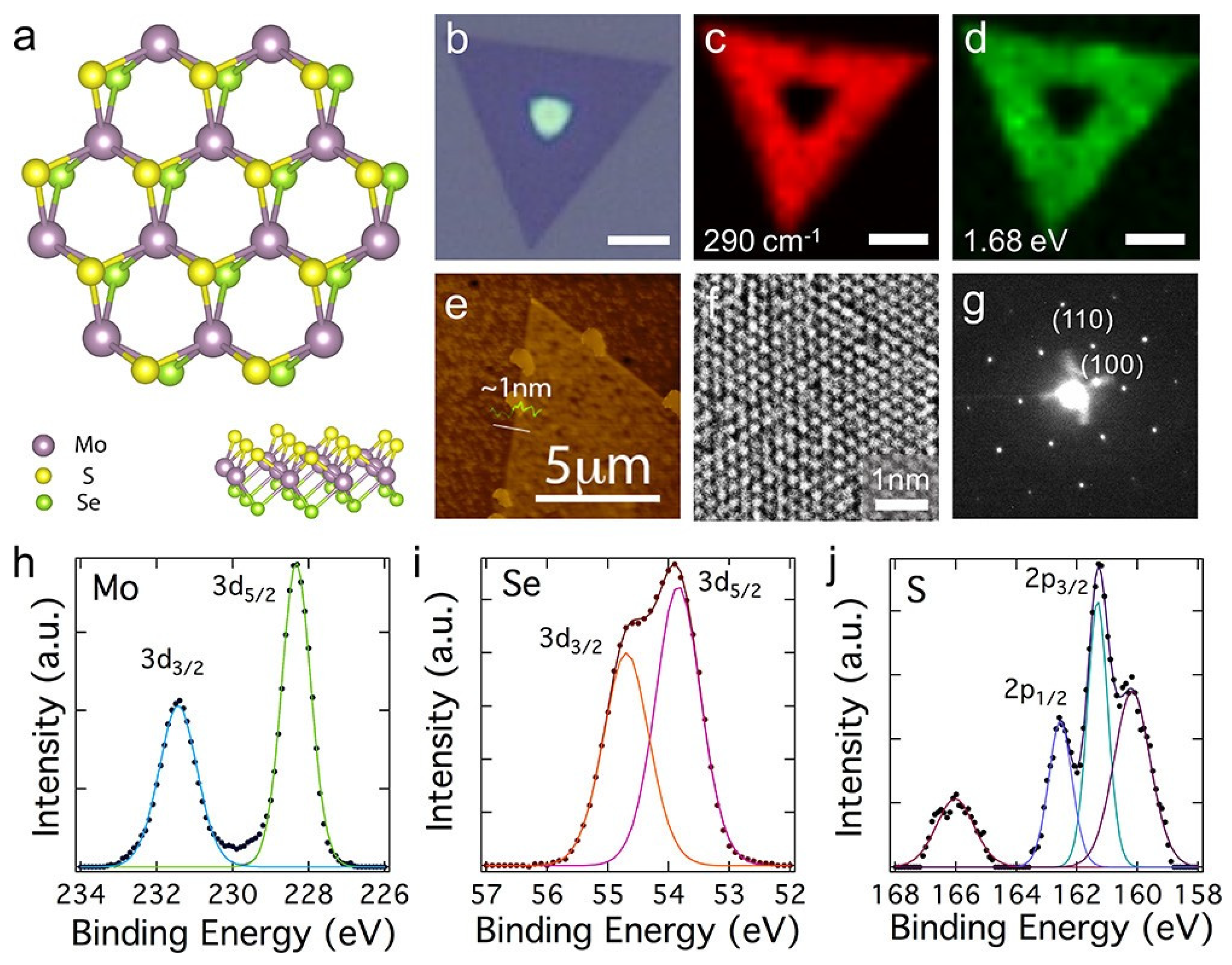
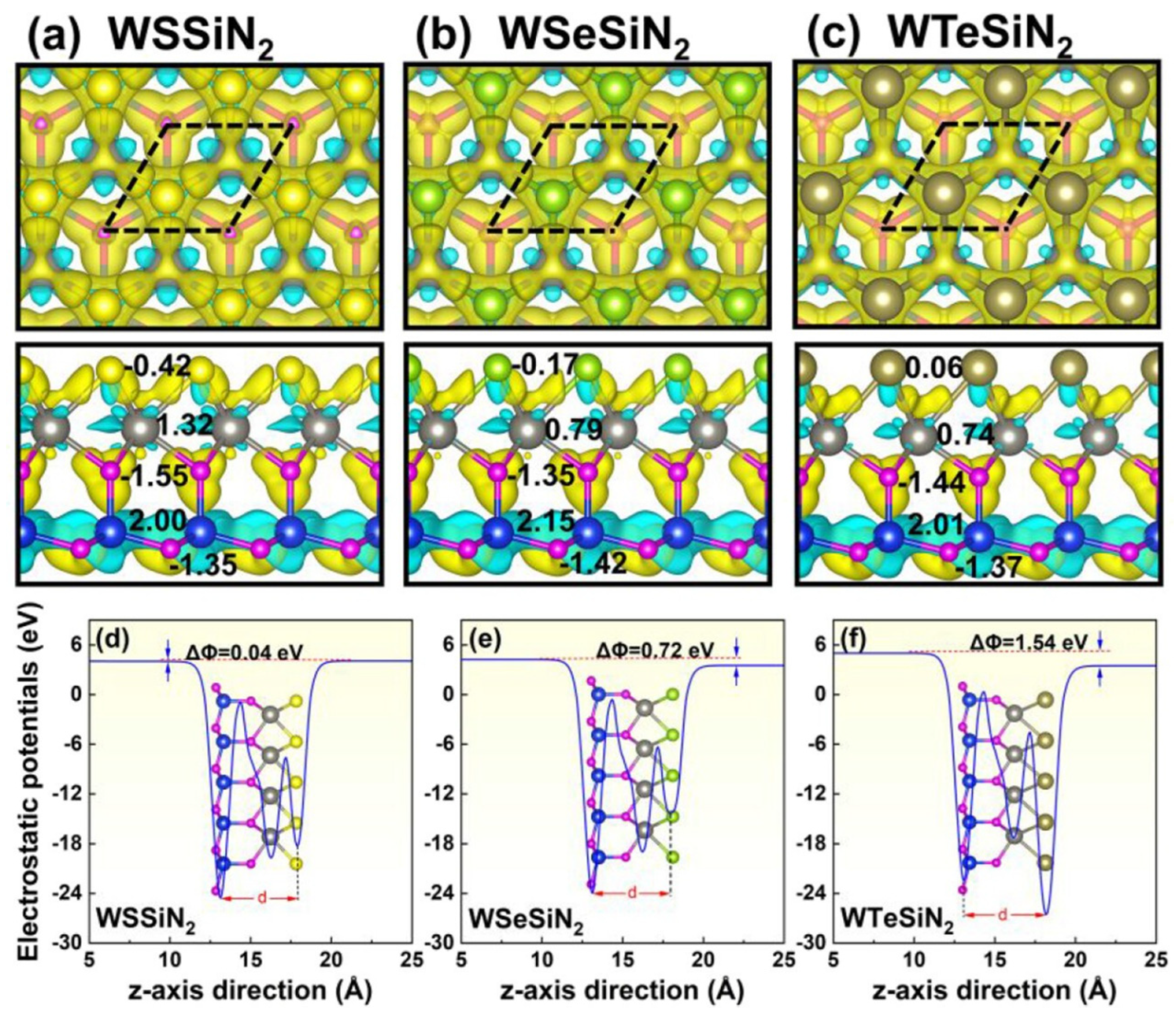
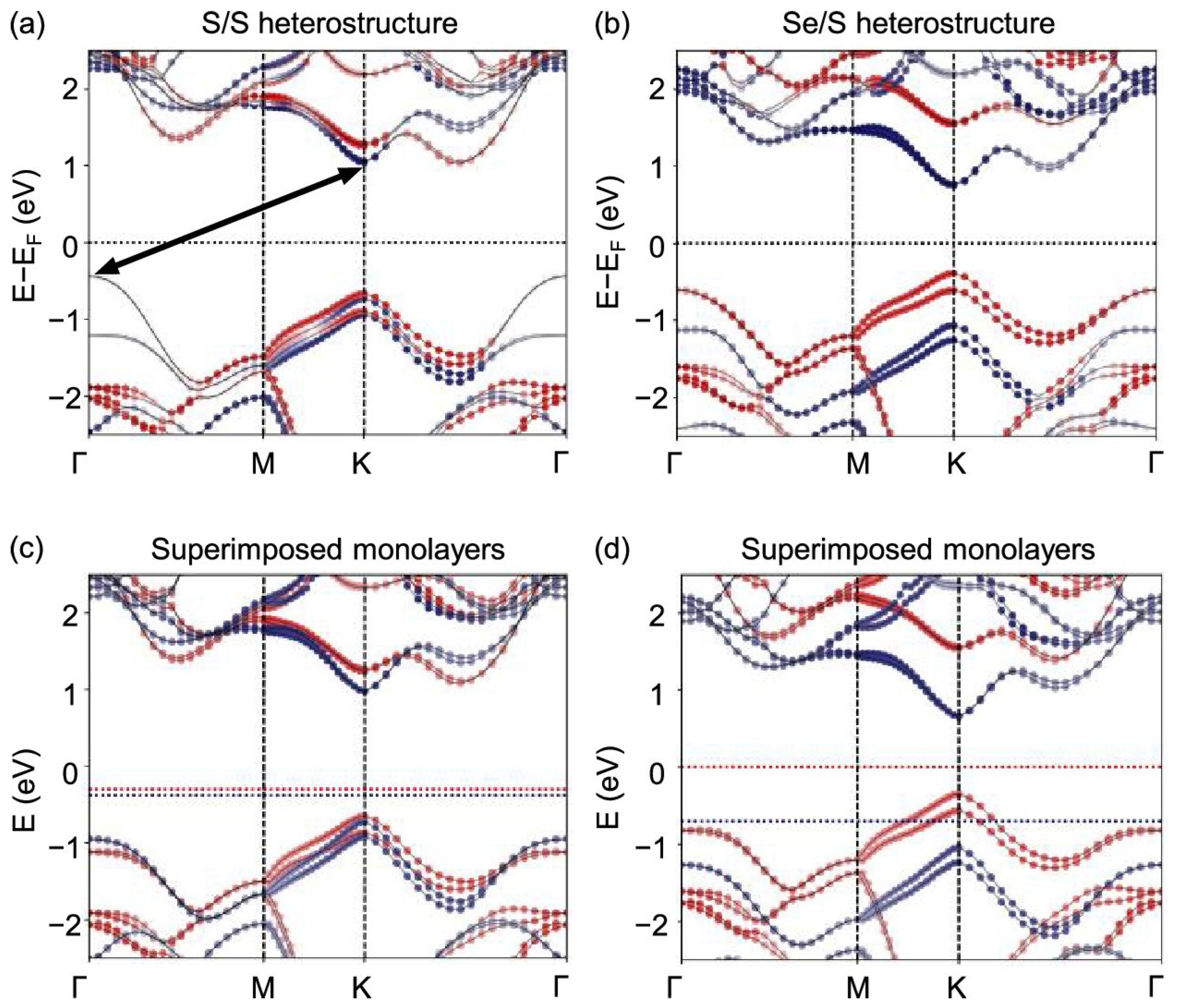

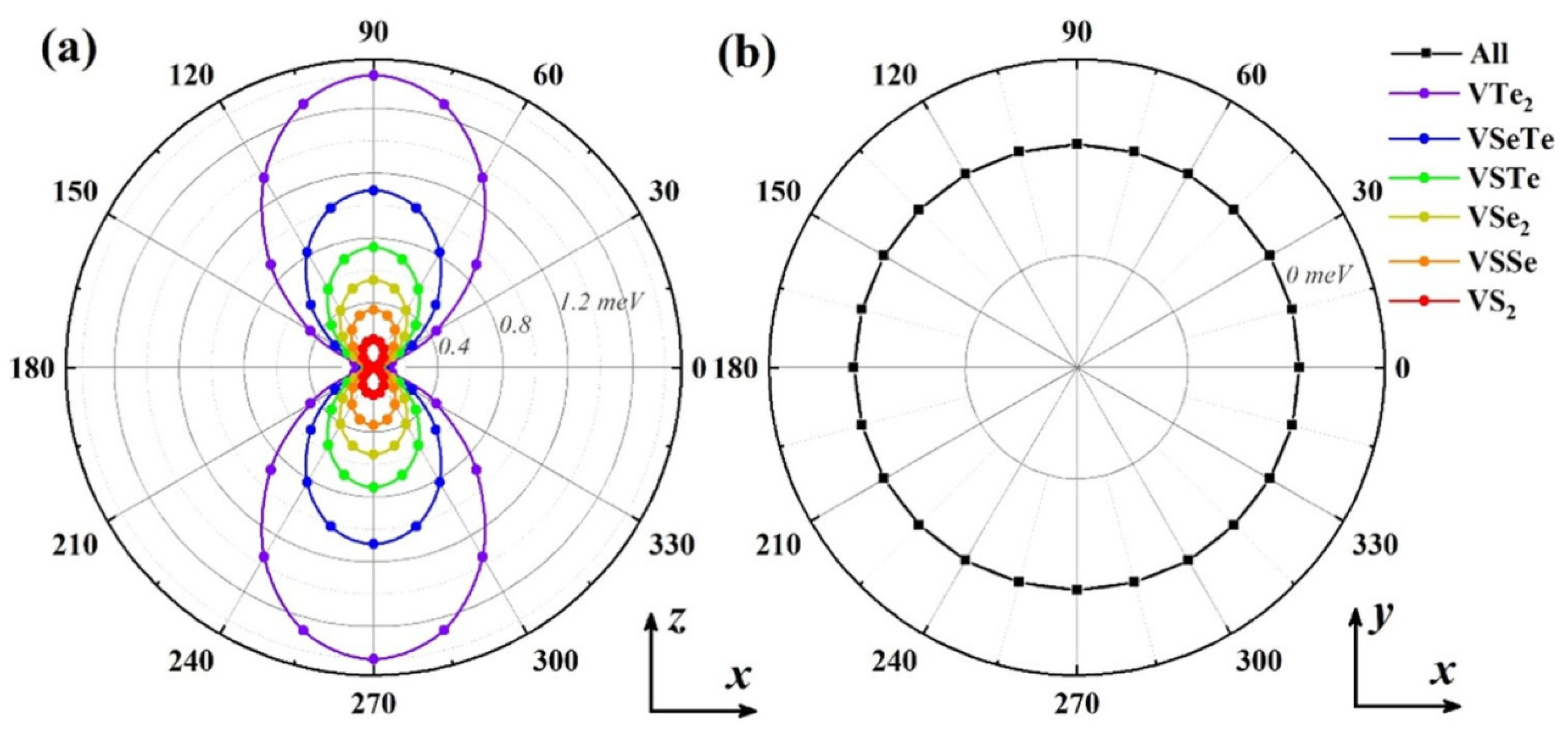
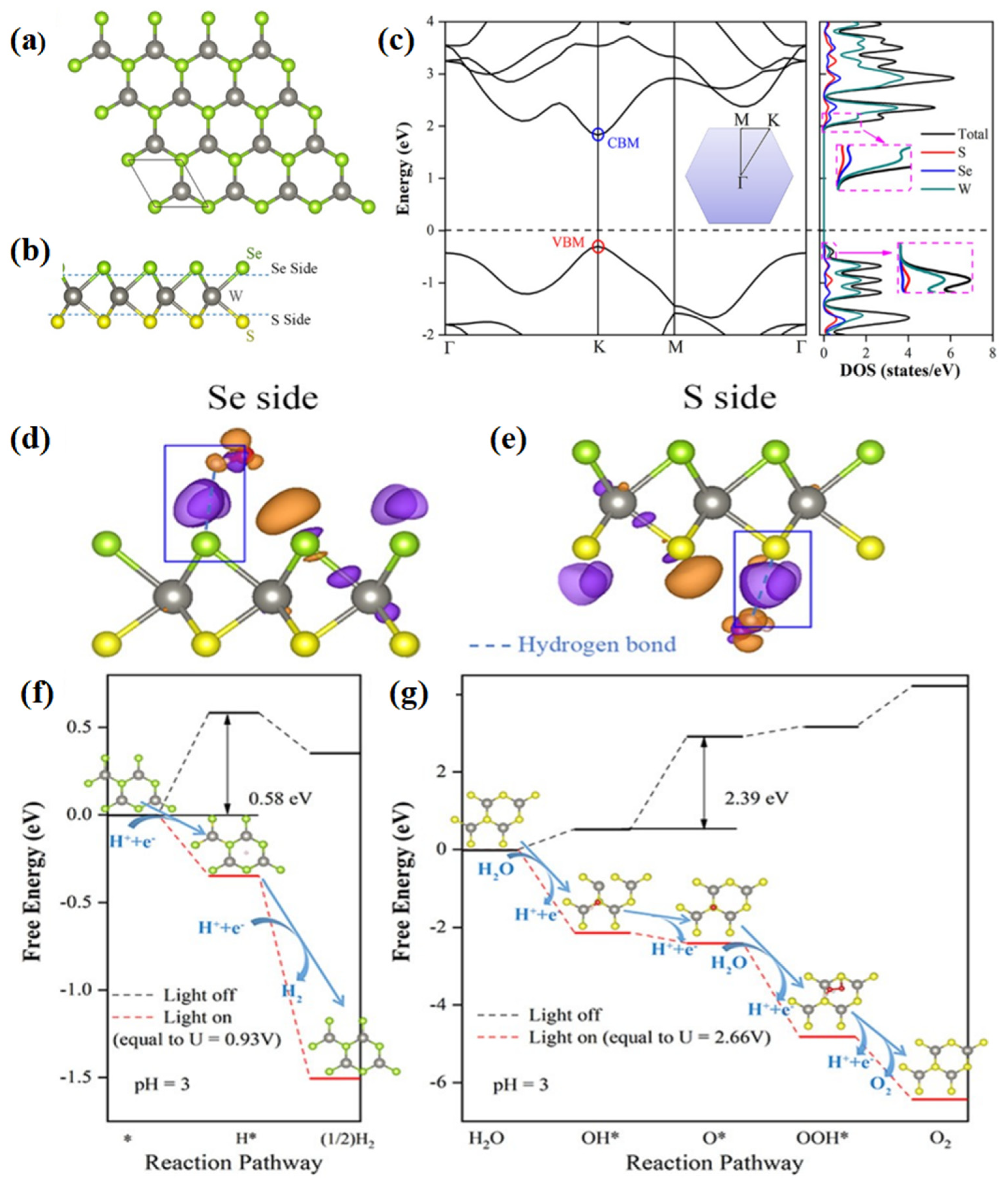
| Material Types | Structure | Band Gap (eV) | Band Gap Type | Electron Mobility (cm2/V·s) | Spontaneous Polarization |
|---|---|---|---|---|---|
| MoSSe (Single layer) | Asymmetric layered | 2.082 | Indirect/Direct | 65.82 | yes |
| WSSe (Single layer) | Asymmetric layered | 2.252 | Indirect/Direct | 120.88 | yes |
| MoS2 (Single layer) | Symmetrical layer | 1.7–2.5 | Direct | 130–410 | no |
| h-BN | Symmetrical layer | 4.6–6 | Indirect | Insulator | no |
| Graphene | Honeycomb | 0 | Metallicity | 15,000–20,000 | no |
Disclaimer/Publisher’s Note: The statements, opinions and data contained in all publications are solely those of the individual author(s) and contributor(s) and not of MDPI and/or the editor(s). MDPI and/or the editor(s) disclaim responsibility for any injury to people or property resulting from any ideas, methods, instructions or products referred to in the content. |
© 2025 by the authors. Licensee MDPI, Basel, Switzerland. This article is an open access article distributed under the terms and conditions of the Creative Commons Attribution (CC BY) license (https://creativecommons.org/licenses/by/4.0/).
Share and Cite
Zhao, H.; Lam, J.C.K. Preparation, Properties, and Applications of 2D Janus Transition Metal Dichalcogenides. Crystals 2025, 15, 567. https://doi.org/10.3390/cryst15060567
Zhao H, Lam JCK. Preparation, Properties, and Applications of 2D Janus Transition Metal Dichalcogenides. Crystals. 2025; 15(6):567. https://doi.org/10.3390/cryst15060567
Chicago/Turabian StyleZhao, Haoyang, and Jeffrey Chor Keung Lam. 2025. "Preparation, Properties, and Applications of 2D Janus Transition Metal Dichalcogenides" Crystals 15, no. 6: 567. https://doi.org/10.3390/cryst15060567
APA StyleZhao, H., & Lam, J. C. K. (2025). Preparation, Properties, and Applications of 2D Janus Transition Metal Dichalcogenides. Crystals, 15(6), 567. https://doi.org/10.3390/cryst15060567






